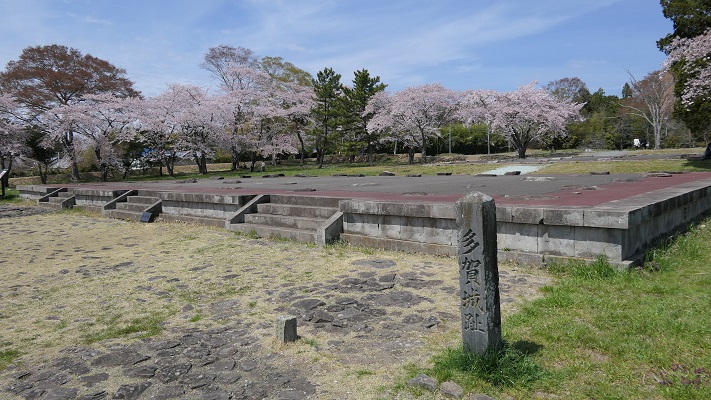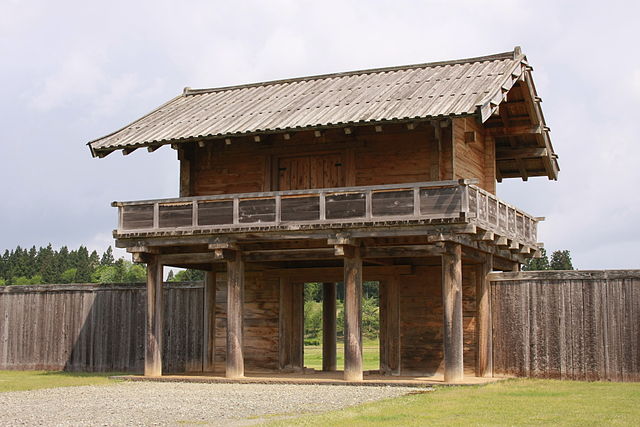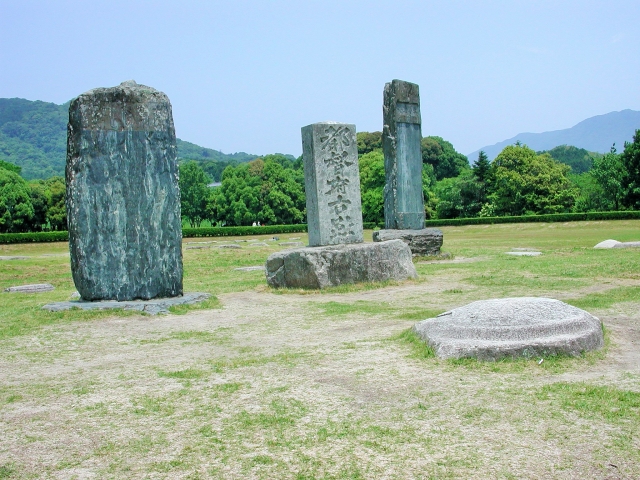大分府内城は、現在はビル街の中にありますが、かつては海城だったのです。
Oita-Funai Castle is among the modern buildings now, but was a sea castle.
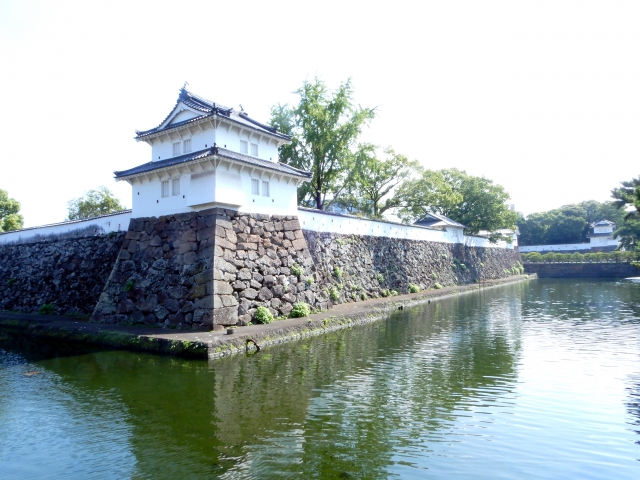
立地と歴史~Location and History
大分市は大分県の県都です。府内は大分市の以前の名前です。つまり「大分府内」という名前は新旧両方の名前が組み合わさったものです。府内も同じように豊後国(大分県の以前の名称)の国府であり、中世においては長い間大友氏によって統治されました。大友氏は、大友氏館に住んでいましたが、そこは大分府内城とは違う場所です。その館は中世の典型的は領主館で、恐らく足利氏館と同じようなものだったでしょう。
Oita City is the capital of Oita Prefecture. Funai is the former name of the city. So, the name “Oita-Funai” is combined from both of new and old names. Funai was likewise the capital of Bungo Province (the former name of Oita Pref.) governed by the Otomo clan for many years in the Middle Ages. They had been living in the Otomo Clan Hall which is different from Oita Funai Castle. It was a typical hall for a lord in the Middle Ages probably like the Ashikaga Clan Hall.
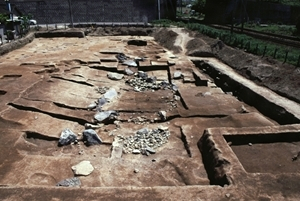
府内の城下町は、館を中心に繁栄しましたが、戦国時代としては防御力が不足していました。1586年に島津氏の侵攻があり、館を含む市街地は焼き尽くされてしまいます。当主の大友宗麟とその息子義統は、その一族の危機の間他所に避難を余儀なくされました。彼らは天下人の豊臣秀吉からの助けにより何とか生き延びましたが、宗麟の死後、義統は秀吉により改易されました。
The Funai castle town flourished around that hall, but it had weak defenses in the Warring States Period. In 1586, Shimazu clan’s invasion happened. The city including the hall was burned out . The master, Sorin Otomo and his son Yoshimune had to escape to another place, during the destruction of the clan. They could somehow survive due to the help from the ruler, Hideyoshi Toyotomi. However, Yoshimune was fired by Toyotomi after Sorin passed away.
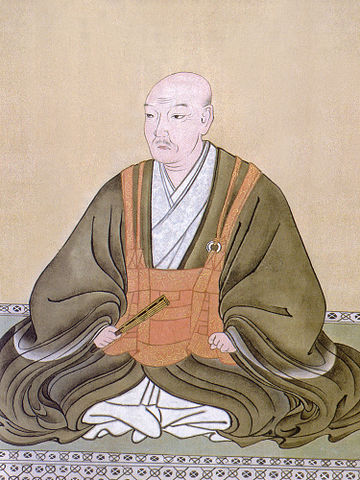
そして秀吉は彼の配下である福原直孝を、1597年に府内の領主とて派遣しました。直孝はもっと安全な城が必要と考え、荷の積み降ろし港の場所に新しい城を築き始め、「荷揚(荷を積むという意味)城」と名付け、その後いつしか「府内城」と改名されました。17世紀初期に、竹中氏が4層の天守や多くの櫓を含む城として完成させ、九州地方では有数な城となったのです。
Then, Toyotomi sent his man, Naotaka Fukuhara as the lord of Funai in 1597. Fukuhara thought that he needed to have a more secure castle. He started to build a new castle at a port of unloading, called “Niage Castle” (Niage means unloading), which was renamed to “Funai Castle” sometime later. In the first 17th century, the Takenaka clan completed the castle including the four-layer Tenshu keep and many turrets, becoming a prominent castle in Kushu region.
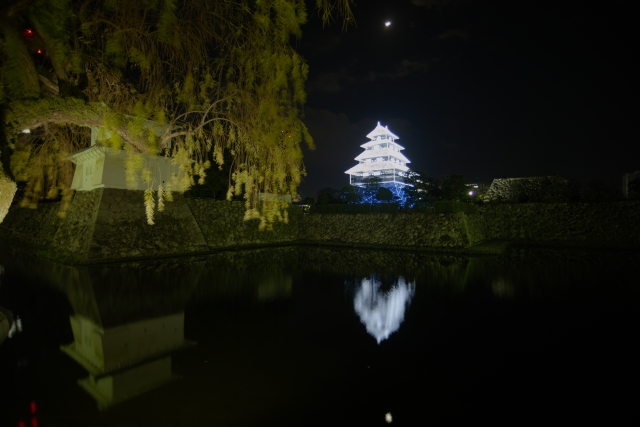
城の中心は安全確保と交通の便のため、細い堤を挟んで大分川の河口に面していました。河口から、本丸から二の丸へ、更には三ノ丸まで外側に向かって広がっていて、水堀によって互いに隔てられていました。特に二の丸へは、「廊下橋」と呼ばれた二つの橋のみが通じていて、もしこれらの橋を落とした場合、本丸と二ノ丸は完全に外部から遮断されるようになっていました。
The center of the castle faced the estuary of Oita River across a thin bank for safety and transportation. From the estuary, the main enclosure “Honmaru”, to the second enclosure “Ninomaru” until the third enclosure “Sannomaru” spread towards outside, separated by water moats each other. Particularly, only two bridges called “Roka-Bashi” led to Ninomaru area. If these bridges were fallen, the Honmaru and Ninomaru could be shut down from outside.
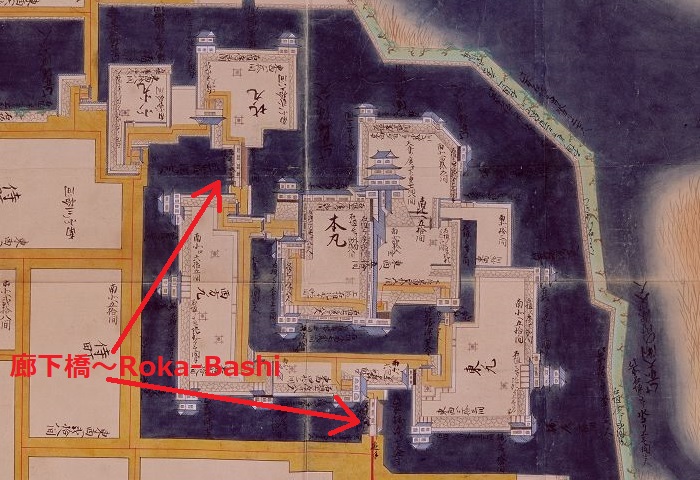
しかし、松平氏統治下の1743年に城下町の大火による被害を被りました。天守を含むほとんどの城の建物が焼け落ちました。その後、櫓はいくつか再建されましたが、天守は再建されませんでした(天守台だけが残ります)。
But in 1743, under the Matsudaira clan’s governance, the castle suffered from a great fire around the castle town. Most of the buildings of the castle including Tenshu keep were burned down. After that, some turrets were restored, but Tenshu wasn’t (just the Tenshu base remains).
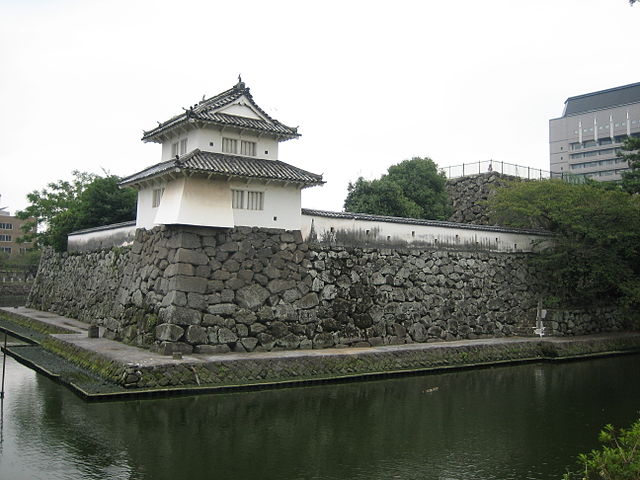
特徴~Fertures
現在、本丸と二ノ丸の範囲は「大分城址公園」として公園になっています。この公園は今でも二の丸の水堀と石垣に囲まれています。しかし本丸の水堀は埋められていて、そのため公園の範囲はただ一つの曲輪のように見えます。ここにはまた櫓もあり、そのうち2つだけが元からあるものです(人質櫓と宗門櫓)。更には、一基の廊下橋が最近復元されました。
Now, the area of Honmaru and Ninomaru has been turned into a park called “Funai Castle Ruins”. The park is still surrounded by the Ninomaru water moat and stone walls. But the Honmaru water moat has been filled, so the park area looks like just one enclosure. It also has several turrets, out of whom only two turrets are original (Hitojichi-Turret and Shumon-Turret). In addition, one Roka-Bashi has recently been restored.
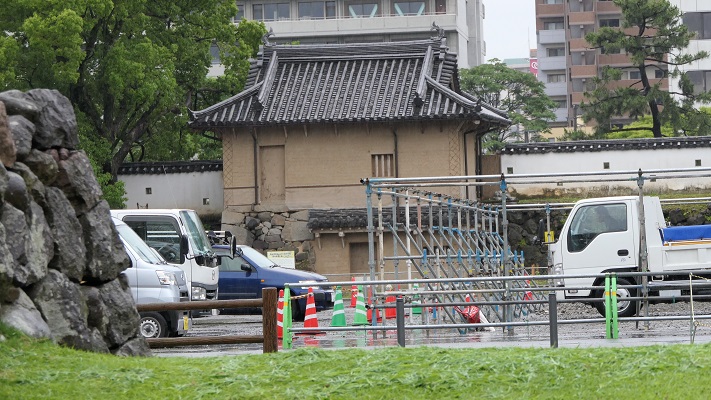
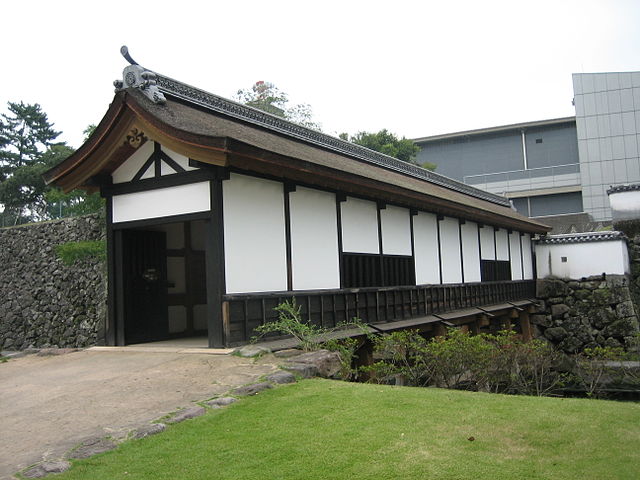
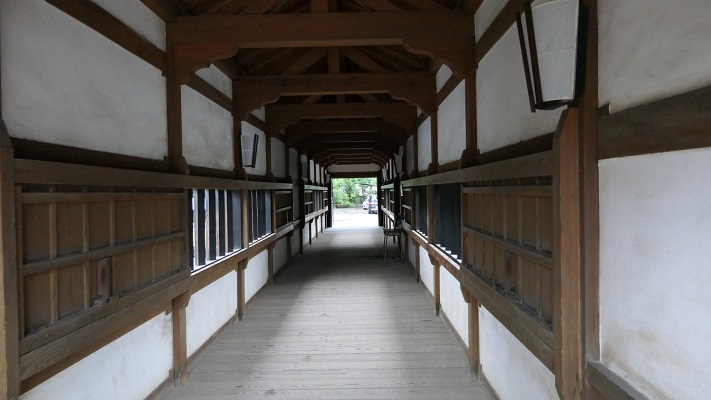
ところが、公園の周りの地域は全て埋め立てられ、近代的な都市に変貌しています。歴史の知識がなければ、ここが海城だったとは想像できません。
However, all area outside the park has been filled in ground for the modernized city. No one can imagine that was a sea castle without historical knowledge.
その後~Later Life
明治維新後、大分県庁が本丸に置かれました。大正時代にその建物が新築拡張されることになり、本丸の水堀が埋め立てられました。第二次世界大戦では、米軍による大分空襲があり、城の現存櫓もいくつか焼けてしまいました。戦後市の復興計画により、城跡は大分城址公園となりました。県庁は以前の三ノ丸に移転し、そして本丸と二ノ丸の範囲は1963年に初めて県の史跡として指定されました。「西南隅櫓」「大手口多門櫓」「着到櫓」といった櫓が外観復元されました。それ以外に模擬櫓もあります。
After the Meiji Restoration, the Oita Prefectural Building was placed on Honmaru area. In the Taisho Era, the building was replaced to a new large one that caused the Honmaru water moat to be filled. In World War II, Oita Air Raid by the US Air Force burned out the Oita city area including several remaining turrets of the castle. After the war, with the reconstruction plan of the city, the castle ruins was turned into Funai Castle Ruins park. Prefectural Building was moved to the former Sannnomaru area, then the area within Honmaru and Ninomaru was first designated as a prefectural historic site in 1963. Some turrets such as “Seinan-Sumi-Turret”, “Oteguchi-Tamon-Turret” and “Chakuto-Turret” were externally restored. There are also some imitational turrets there.

大分市は城跡の将来に向けた整備計画を検討しています。この計画によると、本丸石垣が部分的に復元され、地面に本丸水堀があったことを示す線が表示されることになっています。過去に海城があったことを周知したいようです。
Oita City is considering the development plan for the future of the ruins. They plan to restore part of the Honmaru stone walls and express the line of Hommaru water moat on the ground. They seem to let people know that there was a sea castle in the past.
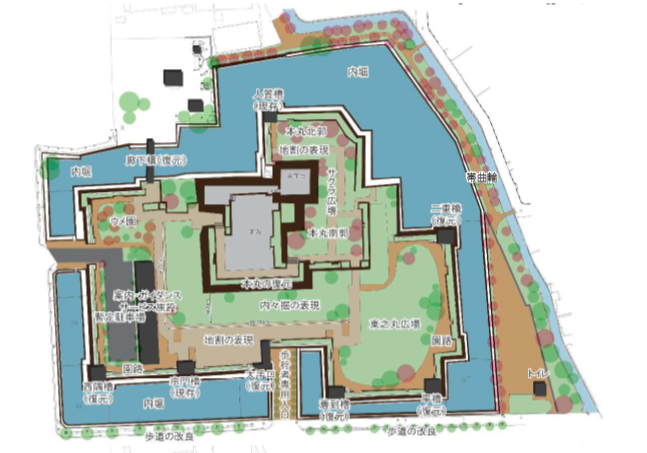
私の感想~My Impression
面白いイベントが城址公園で開催されました。それは、鉄骨のフレームとLEDライトによって天守の姿を再現したものでした。このイベントは終わってしまったのですが、私が最近訪れたときにはまだフレームが残っていました。フレームが存在していれば、また再開することも可能と思います。そうなったらよいですね。
An interesting event was held in the ruin park. That was recreating of the image of the Tenshu keep by using a steel frame and lots of LED light bulbs. Though the event has finished, the frame remained when I visited the ruins recently. The show could be held again as long as the frame is there. Hopefully that will happen.
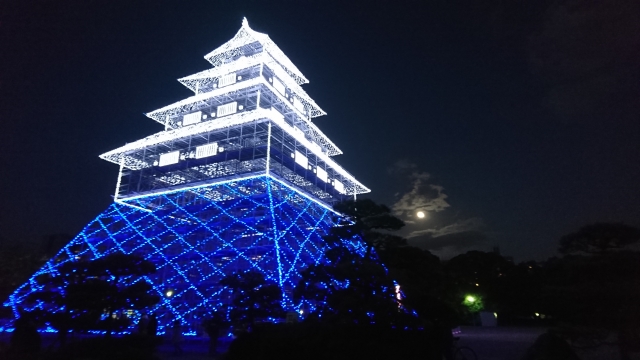
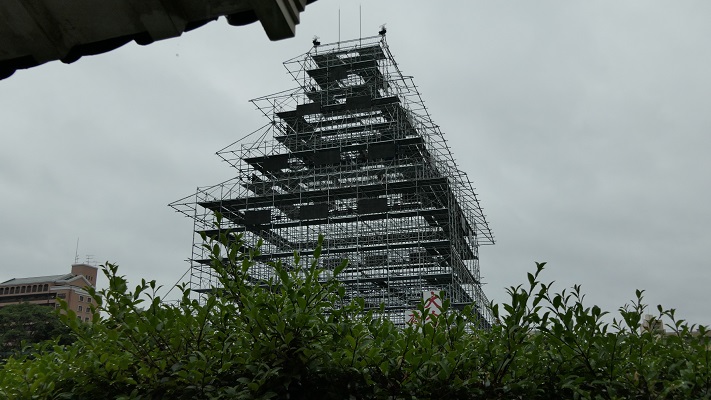
ここに行くには~How to get There
車で行く場合:東九州自動車道大分ICから約20分です。城址公園内に駐車場があります。
大分駅から:徒歩で約15分かかります。バスの場合大分駅南口から「大分きゃんバス」に乗り、市役所前バス停で降りてください。
大分空港から大分駅まで:空港アクセスバス(エアライナー)に乗ってください。
If you want to go there by car: It takes about 20 minutes from the Oita IC on Higashikyushu Expressway. The park offers a parking lot inside.
From Oita station: It takes about 15 minutes on foot. Or take the Oita-Can-bus at the south entrance of the station, and take off at the Shiyakusho-Mae bus stop.
From Oita Airport to Oita st.: Take the Airpor Eepress Airliner bus.
リンク、参考情報~Links and Rererences
・よみがえる日本の城20、学習研究社(Japanese Magazine)
・大分城址公園整備・活用基本計画、大分市(Japanese Document)

